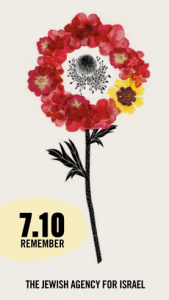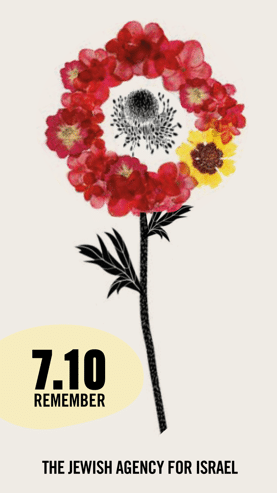
שְּׁמִינִ֔י עֲצֶ֖רֶת Shmini Atzeret
"בַּיּוֹם֙ הַשְּׁמִינִ֔י עֲצֶ֖רֶת תִּהְיֶ֣ה לָכֶ֑ם" (במדבר כ"ט: ל"ה)
שמיני עצרת כחג הוא חידה. החג מצוין בתורה כמצווה – אך ללא סיבה או פירוש. בשבת שמיני עצרת, מתקיימת סיום קריאת התורה ("שמחת תורה"). המושג "עֲצֶרֶת" משמעו התאספות המונית, כינוס של העם. על כן, אנו מבקשות לאמץ את המושג "שמיני עצרת" לטובת פירוש ומשמעות לציון יום השנה למתקפת ה7 באוקטובר: שכן המתקפה התרחשה בשבת, חג שמיני עצרת וכן בקריאה להתאספות המונית של כל העם לזכרון הנרצחים ותפילה לימים טובים יותר.
סמל שמיני עצרת יהיה כלנית. למה כלנית?: הכלנית היא הפרח המוכר והאהוב ביותר בקרב הישראלים, ונבחרה לפרח הלאומי של מדינת ישראל. בארץ ישראל נפוצה הכלנית מצפון הארץ עד הר הנגב. מקור שמה המדעי של הכלנית Anemone ופירושו ביוונית הוא "בת רוח". המשמעות של זה היא שהכלנית אינה "מפחדת" מהרוח כיתר הפרחים המעדיפים להמתין לבוא האביב. היא פורחת בחורף. את השם העברי של הכלנית העניק לה עמנואל לעף, חוקר שמות עבריים קדומים שחי בהונגריה בסוף המאה ה-19. הוא בחר בשם "כלנית" כדי לתאר את יופיו של הפרח- ככלה המתהדרת.
אנו מזמינים אותך לציין את שמיני עצרת בדרכים הבאות:
1. לקיים עצרת קהילתית
2. לשים את מדבקת הכלנית קרוב ללבך
3. לקיים טקס קצר או לשלב קטעי קריאה ושירה בטקס קיים
4. ליזום פעילות סביב שמיני עצרת וה- 7/10
Shmini Atzeret
"On the eighth day you shall hold a solemn gathering" (Numbers 29:35)
Shmini Atzerte is noted in the Torah as a mitzvah – but without reason or explanation. On the eighth Shmini Sabbath of the assembly, the end of the reading of the Torah ("Simchat Torah") takes place. The term "Atzeret" means a mass gathering of the people. Therefore, we would like to adopt the term "Shmini Atzeret" as the thematic Jewish framework to mark the anniversary of the October 7th Massacre: a call for a mass gathering of the entire Jewish people in memory of the murdered and a prayer for hope and better days.
Shmini Atzeret is marked with the כלנית Kalanit or anemone.
Why כלנית Kalanit or anemone? The anemone is the most familiar and beloved flower among Israelis, chosen as the national flower of the State of Israel. In the Land of Israel, the anemone is widespread from the north of the country to the Southern Negev. The source of the anemone's scientific name in Greek means "windflower". The כלנית Kalanit or anemone is not "afraid" of the wind like the other flowers that prefer to wait spring. It blooms in winter. The Hebrew name of the anemone was given to it by Emanuel Lef, a researcher of ancient Hebrew names who lived in Hungary at the end of the 19th century. He chose the name " כלנית Kalanit" like כלהKala (meaning bride) to describe the beauty of the flower, just like a bride on her wedding day.
We invite you to mark Shmini Atzeret שמיני עצרת:
a. Holding a (mass) communal gathering
b. Wearing the symbol of Kalanit next to your heart
c. Using the following poems and texts (please note hyperlinks to audio) as inspirational readings for your gathering
d. Run activities to different age groups- suggestions can be found on the Madaf website
טקסטים והצעות לפעילות Texts and Content
- פרויקט שמיני עצרת- מידע עברית אנגלית
- הצעות לפעילויות לפרויקט שמיני עצרת
- טקסטים מוצעים לטקס- עברית אנגלית
- Shmini Atzerte- Portuguese
- Shmini Atzerte- Spanish
- Chmini Atsérèt



